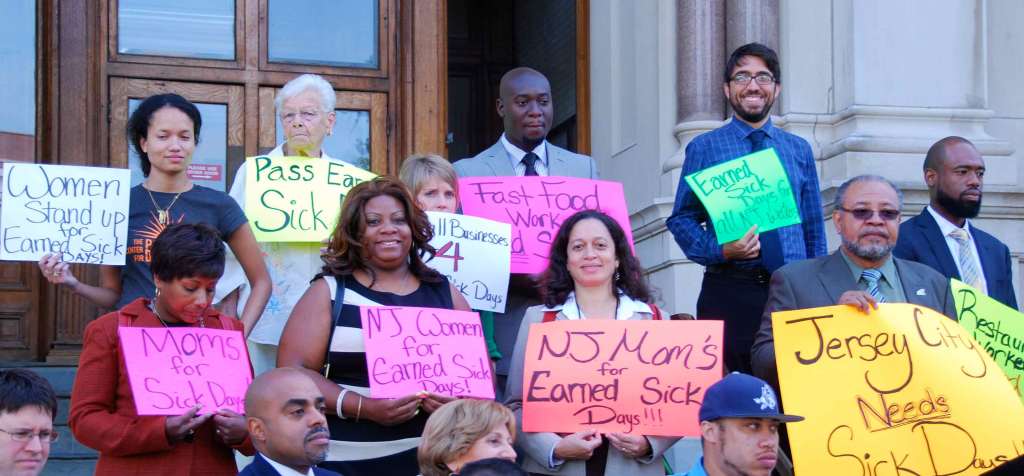
We were thrilled last week to hear President Obama’s announcement of a new push by the White House to make paid family leave and paid sick days a reality for all American families, followed by his emphasis on the issue in his State of the Union address. The high-level Commission on Inclusive Prosperity also released a report which analyzes the growth of inequality in the US, and lays out a plan to address it. Among the commission’s recommendations are paid sick days and family and medical leave insurance, and for good reason: As the President said when announcing his plan, it is “one piece of what needs to be a really aggressive push to ensure that if you work hard in this country then you can make it.”
The lack of paid sick days and paid family leave laws in the United States exacerbates current inequalities, hinders economic mobility for today’s workers, and perpetuates that inequality across generations. The string of victories in states and cities around the country—and eventual changes in federal policy—will not only help address inequality today, but will help families achieve the American dream of upward mobility for themselves and their children.
Access to a few days off to recover from the flu (paid sick days) and extended time off with pay to care for a newborn or seriously ill family member (paid family leave) is inversely proportional to income. According to the Center for American Progress, among high earners, two-thirds get paid parental leave and three-quarters have paid sick days. But for the lowest-wage workers, only 10 percent have paid family leave, and just 15 percent have paid sick days. Latinos are least likely to work in jobs with either of these benefits. And although women and men have equal access, women are still much more likely in our culture to take time off for caregiving.
As a result of these inequalities of access, those who can least afford it are most likely to lose critical income when they or their family members are sick, acquire demerits, or be seen by employers as “unreliable.” They may get fired for being sick, tend not to be considered for promotions, and often lose or quit their jobs when they have a child or need to care for a seriously ill relative, leading to poverty spells and debt accumulation. The lack of paid sick days and paid family leave therefore makes it more likely that low-income people churn at the bottom of the labor market. The loss of income accumulates over a lifetime, with an especially hard hit on mothers’ lifetime earnings, in what is sometimes called the “mommy tax.”
We are always told that the best path to achieving the American dream is to save—to invest in a home, advance your education, enable your kids to go to college, and have some security in retirement. But the lack of paid sick days and family leave, and the resulting income volatility, makes it harder for families to build up assets, often forcing them to deplete their assets when illness strikes or a child is born, and pushing them to exploitative financial products. This not only hinders economic mobility for low-income families, it actually often pushes middle-income families down the economic ladder. Sadly, as Elizabeth Warren found when she was a researcher at Harvard, “having a child is now the single best predictor that a household will end up in financial collapse.” Just last week, Bloomberg Businessweek’s cover story on maternity leave recounted several examples of middle-class couples who had to stop paying into retirement and rack up credit card debt when their child was born.
Perhaps the most pernicious effect of unequal access to paid family leave and sick days is the way it perpetuates inequalities across generations. Imagine two families. In one, the mother can take sick days for prenatal checkups, and parents have time to bring their kids to the doctor for all those important immunizations in the first year of life. The mother can recover from pregnancy and breastfeed, and both parents can take time off to bond with their newborn. Once the child is in day care and school, they can attend parent-teacher conferences, and pick up their child when they get the inevitable call that she is running a fever.
In the other family, the mother risks being fired if she asks for a stool to sit on while stationed at a cash register all day—she certainly can’t afford to take time off for prenatal doctors visits. She can’t afford to take more than two weeks off from work after giving birth, making breastfeeding extremely challenging. Quickly returning to work increases maternal depression and makes it hard for children to bond with their parents, with proven effects on toxic stress and brain development. The call from school when the child has an asthma attack becomes a devastating choice, with job loss hanging in the balance. Neither parent can take time off to meet with the child’s teachers, and when that first child is in high school and their baby sister gets sick, the older sibling must miss school to care for her.
We can turn this vicious cycle around. Over the past two years, at the ballot box, in state legislatures and city councils around the country, 17 cities and states have passed laws ensuring that workers have access to a minimum number of paid sick days and setting up insurance funds for paid family leave. And we are poised for more wins in the years to come. As a result, 9 million people and counting can now see a clearer path to the American dream for themselves and their children.
More Information
- Learn more about the critical work of our partners Family Values @ Work, National Partnership for Women and Families, and A Better Balance.
- Watch a video about Ellen Bravo, executive director of Family Values @ Work, who has been at the forefront of the fight to bring low-wage-earning people the benefits and opportunities they need to support their families.
